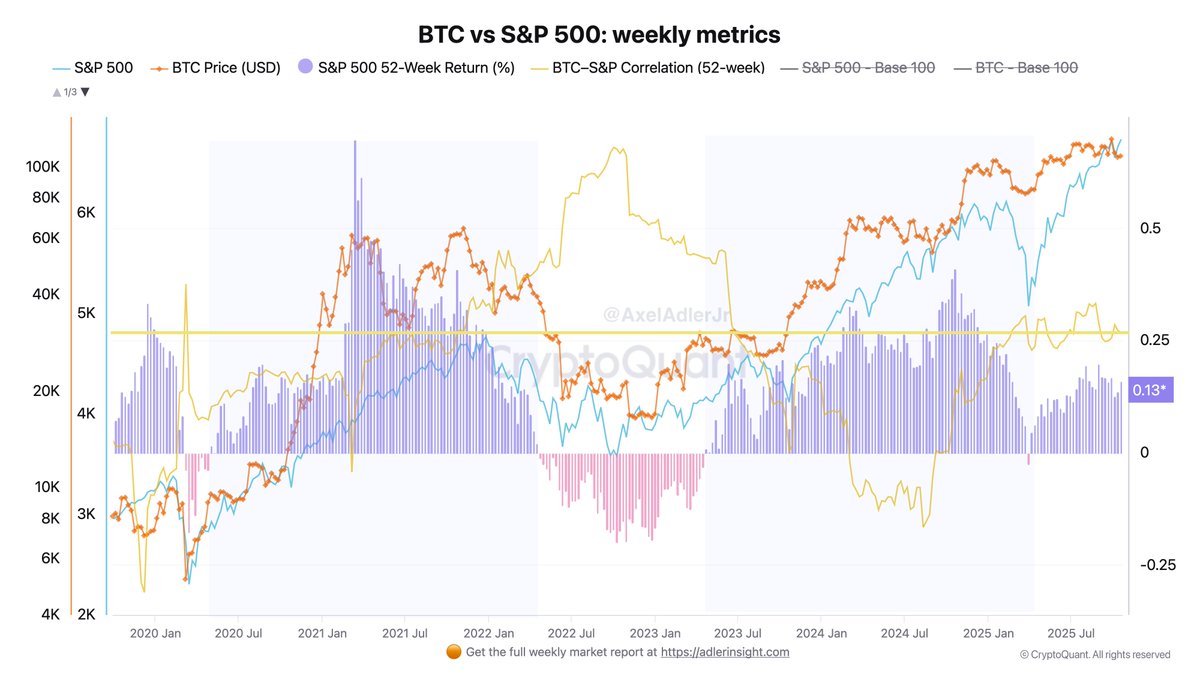Bitcoin continues to struggle to break decisively above the $110,000 mark following the October 10 market crash, as volatility and uncertainty dominate sentiment. The market now stands at a critical crossroads — one that could define whether the next phase brings a deep correction or sets the stage for a massive recovery.
According to top analyst Axel Adler, both Bitcoin and the S&P 500 remain in what he calls the late bull phase. The S&P 500’s 52-week return currently sits at +13%, reflecting that global markets remain in a risk-on environment, with investors still willing to take exposure to growth-oriented assets. Adler notes that the BTC–S&P correlation currently stands at 0.26, meaning Bitcoin tends to move in the same direction as equities, though not entirely in lockstep.
This moderate correlation suggests that while macro factors like earnings and monetary policy still influence Bitcoin, its internal dynamics — such as liquidity shifts and derivatives positioning — remain key. However, Adler warns that the S&P 500’s sensitivity to macro and political narratives could quickly spill over into the crypto market. Any cooling in equities or broader risk sentiment could pressure Bitcoin and define its next major move.
Bitcoin Mirrors Late-Cycle Market Behavior as Q4 Earnings Take Center Stage
According to Axel Adler, the final quarter of 2025 marks a crucial transition point for both traditional and crypto markets. After nearly two years of steady yield growth and tight monetary policy, the macro focus is shifting from expectations to real corporate performance. The Q3 earnings season is now in full swing, and early results have been surprisingly strong — out of 58 companies that have reported so far, all have beaten estimates by an average of 571 basis points (bps). Moreover, expected earnings growth for the quarter has climbed from 7% to 8%, reinforcing the idea that markets are still in the final phase of a bull cycle.
This late-cycle behavior typically reflects investor optimism, even as underlying risks — such as stretched valuations, declining liquidity, and macro uncertainty — begin to surface. Adler notes that such conditions often coincide with high volatility across risk assets, including Bitcoin, which tends to track broader shifts in investor sentiment.
For crypto markets, this context is particularly relevant. Bitcoin’s muted reaction to strong earnings data suggests that institutional flows remain cautious, waiting for confirmation of macro stability before re-entering risk positions. Historically, when equity markets approach the peak of their bull cycle, Bitcoin can either decouple and surge amid renewed liquidity or follow equities downward during a correction phase.
Adler concludes that the current setup aligns with a late-bull, pre-cooling environment — a moment defined by strong short-term optimism but fragile long-term balance. The coming weeks, driven by the remaining earnings reports and central bank commentary, will determine whether this momentum fuels another Bitcoin rally or marks the beginning of a broader market cooldown.
Bulls Defend Key Support, Market Awaits Breakout Confirmation
Bitcoin is currently trading around $109,300, showing modest recovery momentum after finding support near the 100-day moving average (green line). The 3-day chart reveals that BTC remains in a consolidation structure, oscillating between $106,000 and $117,500, the latter acting as a significant resistance level since mid-September.
The $117,500 zone continues to mark the upper boundary of the current range, aligning with the previous high-volume node from the August–September period. This level represents the Point of Control for the recent trading structure and is critical for defining short-term direction. A successful breakout above it would likely trigger momentum toward $123,000, where large liquidity clusters and short liquidations are positioned.
On the downside, the 50-day moving average (blue line) sits near $111,000, overlapping with the mid-range level, while the 200-day moving average (red line) near $90,000 remains a longer-term support base.
Bitcoin’s trend remains neutral-to-bullish, but confidence is fragile. A strong close above $111,000–$112,000 could signal renewed strength, while a rejection here would likely confirm extended consolidation or even a deeper correction toward $105,000. The next few sessions will determine whether BTC can regain momentum or face renewed selling pressure.
Featured image from ChatGPT, chart from TradingView.com

